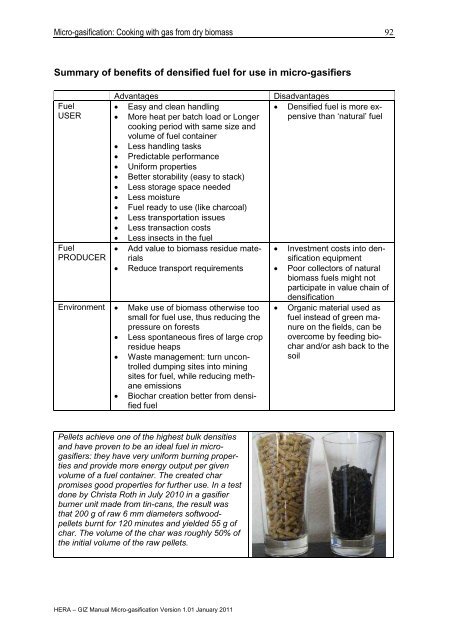Micro-gasification: Cooking with gas from biomass - Amper
Micro-gasification: Cooking with gas from biomass - Amper
Micro-gasification: Cooking with gas from biomass - Amper
Create successful ePaper yourself
Turn your PDF publications into a flip-book with our unique Google optimized e-Paper software.
<strong>Micro</strong>-<strong><strong>gas</strong>ification</strong>: <strong>Cooking</strong> <strong>with</strong> <strong>gas</strong> <strong>from</strong> dry <strong>biomass</strong><br />
Summary of benefits of densified fuel for use in micro-<strong>gas</strong>ifiers<br />
Fuel<br />
USER<br />
Fuel<br />
PRODUCER<br />
Advantages Disadvantages<br />
Easy and clean handling<br />
More heat per batch load or Longer<br />
cooking period <strong>with</strong> same size and<br />
volume of fuel container<br />
Less handling tasks<br />
Predictable performance<br />
Uniform properties<br />
Better storability (easy to stack)<br />
Less storage space needed<br />
Less moisture<br />
Fuel ready to use (like charcoal)<br />
Less transportation issues<br />
Less transaction costs<br />
Less insects in the fuel<br />
Add value to <strong>biomass</strong> residue materials<br />
Reduce transport requirements<br />
Environment Make use of <strong>biomass</strong> otherwise too<br />
small for fuel use, thus reducing the<br />
pressure on forests<br />
Less spontaneous fires of large crop<br />
residue heaps<br />
Waste management: turn uncontrolled<br />
dumping sites into mining<br />
sites for fuel, while reducing methane<br />
emissions<br />
Biochar creation better <strong>from</strong> densified<br />
fuel<br />
Pellets achieve one of the highest bulk densities<br />
and have proven to be an ideal fuel in micro<strong>gas</strong>ifiers:<br />
they have very uniform burning properties<br />
and provide more energy output per given<br />
volume of a fuel container. The created char<br />
promises good properties for further use. In a test<br />
done by Christa Roth in July 2010 in a <strong>gas</strong>ifier<br />
burner unit made <strong>from</strong> tin-cans, the result was<br />
that 200 g of raw 6 mm diameters softwoodpellets<br />
burnt for 120 minutes and yielded 55 g of<br />
char. The volume of the char was roughly 50% of<br />
the initial volume of the raw pellets.<br />
HERA – GIZ Manual <strong>Micro</strong>-<strong><strong>gas</strong>ification</strong> Version 1.01 January 2011<br />
Densified fuel is more expensive<br />
than ‗natural‘ fuel<br />
Investment costs into densification<br />
equipment<br />
Poor collectors of natural<br />
<strong>biomass</strong> fuels might not<br />
participate in value chain of<br />
densification<br />
92<br />
Organic material used as<br />
fuel instead of green manure<br />
on the fields, can be<br />
overcome by feeding biochar<br />
and/or ash back to the<br />
soil
















